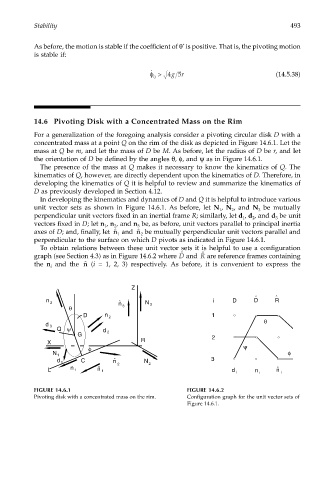Page 512 - Dynamics of Mechanical Systems
P. 512
0593_C14_fm Page 493 Tuesday, May 7, 2002 6:56 AM
Stability 493
*
As before, the motion is stable if the coefficient of θ is positive. That is, the pivoting motion
is stable if:
φ > 4gr (14.5.38)
˙
5
0
14.6 Pivoting Disk with a Concentrated Mass on the Rim
For a generalization of the foregoing analysis consider a pivoting circular disk D with a
concentrated mass at a point Q on the rim of the disk as depicted in Figure 14.6.1. Let the
mass at Q be m, and let the mass of D be M. As before, let the radius of D be r, and let
the orientation of D be defined by the angles θ, φ, and ψ as in Figure 14.6.1.
The presence of the mass at Q makes it necessary to know the kinematics of Q. The
kinematics of Q, however, are directly dependent upon the kinematics of D. Therefore, in
developing the kinematics of Q it is helpful to review and summarize the kinematics of
D as previously developed in Section 4.12.
In developing the kinematics and dynamics of D and Q it is helpful to introduce various
unit vector sets as shown in Figure 14.6.1. As before, let N , N , and N be mutually
1 2 3
perpendicular unit vectors fixed in an inertial frame R; similarly, let d , d , and d be unit
1 2 3
vectors fixed in D; let n , n , and n be, as before, unit vectors parallel to principal inertia
1 2 3
axes of D; and, finally, let ˆ n and ˆ n be mutually perpendicular unit vectors parallel and
1 2
perpendicular to the surface on which D pivots as indicated in Figure 14.6.1.
To obtain relations between these unit vector sets it is helpful to use a configuration
ˆ
ˆ
graph (see Section 4.3) as in Figure 14.6.2 where and are reference frames containing
R
D
the n and the ˆ n (i = 1, 2, 3) respectively. As before, it is convenient to express the
i
Z
ˆ
ˆ
n 3 ˆ n N 3 i D D R
θ 3
D n 2 1
θ
d 3
Q ψ d 2
G 2
X R ψ
φ
N 1 φ
C 3
d 1 n ˆ N
2 2
L n 1 n ˆ 1 d n n ˆ
i i i
FIGURE 14.6.1 FIGURE 14.6.2
Pivoting disk with a concentrated mass on the rim. Configuration graph for the unit vector sets of
Figure 14.6.1.

